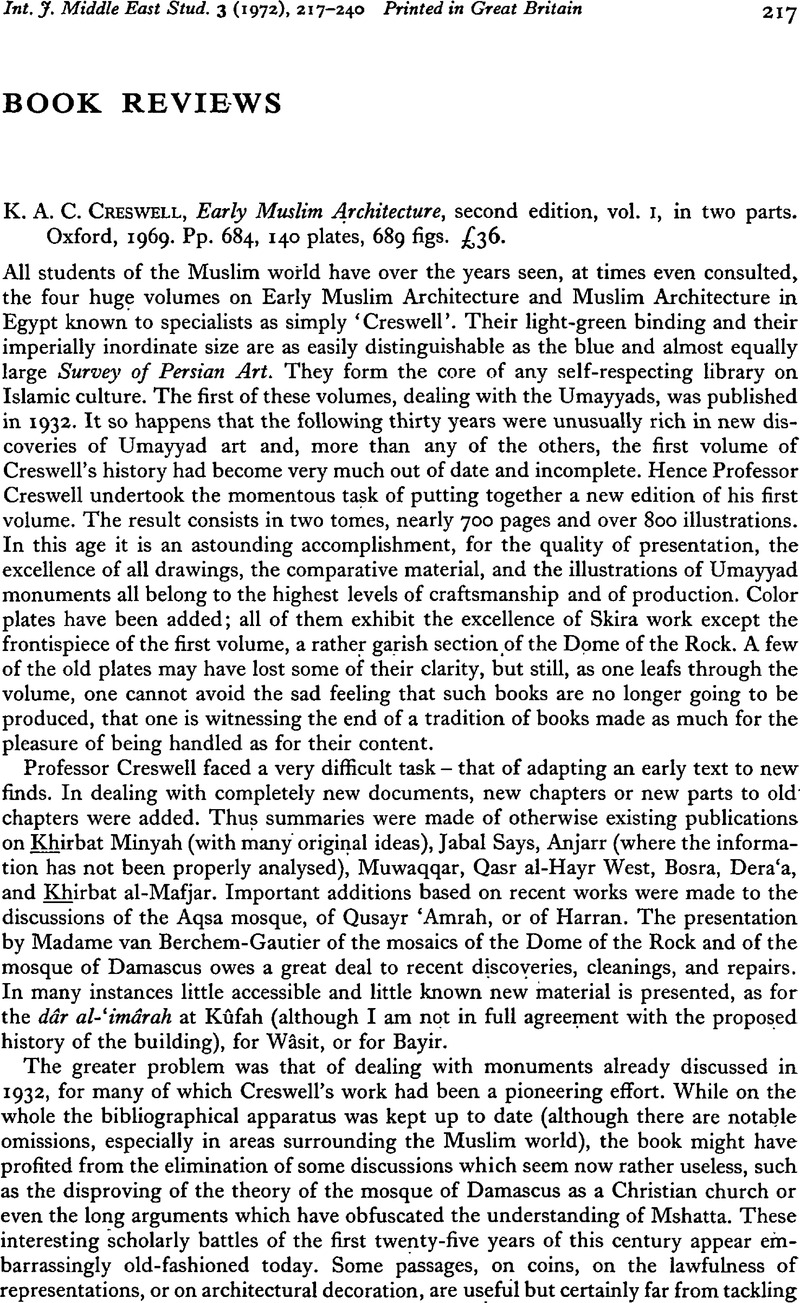No CrossRef data available.
Published online by Cambridge University Press: 29 January 2009

page 218 note 1 In the context of this article there is not much point in listing all such additions to be made to the book, since they are available elsewhere (see note 5 below, and note 1, p. 221).Google Scholar
page 218 note 2 O., Grabar, ‘The Umayyad Dome of the Rock’, Ars Orientalis, Vol. m (1957).Google Scholar
page 218 note 3 J., Sauvaget, ‘Remarques sur les monuments omeyyades’, Journal Asiatique, vol. ccxxxi (1939).Google Scholar
page 218 note 4 It is curious, for instance, that H. Stern's article ‘Les origines de l'architecture de la Mosquae omeyyade’, Syria, vol. xxvm (1951), which solves simply and neatly a major problem of Mshatta, is not mentioned at all.Google Scholar
page 218 note 5 Many of these problems will be taken up in a book on The Formation of Islamic Art scheduled to be published by the Yale University Press in 1972.Google Scholar
page 218 note 6 Thus the forthcoming work on the completed excavations at Qasr-al-Hayr East will modify Creswell's conclusions in very many ways.Google Scholar
page 219 note 1 H., Lammens,‘La “badia” et la “hira” sous les Omeyyades’, Mélanges de la Faculté Orientate, Université St Joseph, vol. iv (1910).Google Scholar
page 219 note 2 E., Herzfeld,‘ Mshatta, Hira, und Badiya’, Jahrbuch derPreussischen Kunstsammlungen, vol. XXII (1921).Google Scholar
page 219 note 3 A., Musil, Palmyrena (New York, 1927), pp. 296 ff.Google Scholar
page 219 note 4 Sauvaget's key article in the Journal Asiatique is almost entirely a documentation against the theory, but Sauvaget did not say so precisely and therefore his argument is not reflected in Creswell's work.Google Scholar
page 219 note 5 J., Sauvaget, ‘Châteaux omeyyades de Syrie’,Revue des Etudes Islamiques, vol. xxxix (1967). I may add that I had taken up some of these problems in my ‘Umayyad Castles and the Abbasid revolution’, Studia Islamica, vol. xvm (1963), an article apparently ignored by Creswell. On the problem of hlrah, one should consult now I. Shahld, ‘The Etymology of Hira’.Google Scholar
page 219 note 6 The key texts here are the celebrated passages in Tabari, 11, 1737-8, concerning Hisham, n, 1784, concerning Yazid III. The latter uses the word badiyah in the main text but barriyah occurs as a. variant.Google Scholar
page 220 note 1 Adams, R. McC., Land beyond Baghdad (Chicago, 1965) is now the standard work on Iraqi problems and contains several Umayyad buildings.Google Scholar
page 221 note 1 This is a point I have argued in any number of papers published since 1954 (‘The Six Kings at Qasayr Amrah’,Ars Orientalis, Vol. 1).Google Scholar
page 221 note 2 It is accidental that so many excavations of Syrian Islamic monuments have taken place. But it is also true that the slower formation of an Islamic Syria and the totally different ecological circumstances under which it took place explain why so many early monuments were so well preserved.Google Scholar
page 222 note 1 Rodinson, M., ‘De l'archéologie à la sociologie historique’, Syria, vol. xxxviii (1961).Google Scholar For another statement of the same point see Sauvaget, J., ‘Comment étudier l'histoire du monde arabe’, reprinted in Mémorial Jean Sauvaget (Damascus, 1954).Google Scholar
page 222 note 2 Since then L. Golvin has begun a similar gathering of documents limited to religious buildings. See his Essai sur l'Architecture Religieuse Musulmane, 2 vols. (Paris, 1970, 1971).Google Scholar For general problems it is also necessary to consult de Villard, U. Monneret, Introduzione allo Studio dell'artheologia islamica (Venice-Rome, 1966),Google Scholar and the tradition of raising major questions and formulating hypotheses is continued by Sourdel-Thomine, J., ‘La Mosquée et la madrasah’, Cahiers de Civilisation Médiévale, vol. XIII (1970).Google Scholar
page 222 note 3 As Sauvaget had done so consistently, for his fertile mind was always willing to admit his own errors and to correct them. In fact it is a fascinating academicexercise to compare the treatment given by Creswell to the mosque of Damascus with Sauvaget's monograph on the mosque of Madînah and to see how a man's mind affects presumably cold-blooded scientific enterprises.Google Scholar